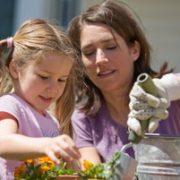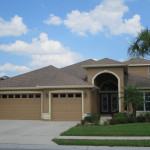5 Florida Gardening and Landscaping Tips
Guest Contributor: Sarah Bacon, Master Gardener & Community Herbalist ~
There are countless reasons to love living in Florida. Towards the top of the list is the ability to grow lush gardens. Florida’s climate allows you to grow plants Northerners can only dream of growing. Have you ever seen a golden canna or saw palmetto growing outside as a perennial in New York? Never! The USDA hardiness zone in the Tampa Bay area is 9B, which means the average minimum-low temperature is between 25 and 30 degrees Fahrenheit. Due to Florida’s mild winters, you have a large variety of plants you can successfully grow.
Of course, we all love the end product, but the actual gardening and landscaping work can seem like a never-ending chore — one that is pushed off until the situation becomes overwhelming. The good news is a happy and mutually beneficial relationship with gardening can exist with some planning and willingness to get your hands dirty. With this sentiment in mind, here are some gardening tips to help you get organized and boost your motivation.
- Make a Garden Plan: Creating a plan truly is the best place to start. It is very common to want to start at a nursery; however, without a plan, you will end up with plants you don’t need or just don’t suit your space. Take the time to scout out your intended garden space and draw out what you would love to see growing. This plan is likely to change along the way, but it is a great place to start.
- Assess Your Garden Space: This is a crucial step to completing your garden plan as well as ensuring the vitality of your future garden.
Questions to ask yourself include:
- How much sun does your space get and at what times of the day?
- How is the drainage? Does water pool up anywhere and drain slowly?
- What type of soil do you have? Sandy? Rocky? Clay? Loam?
- What is the soil’s pH?
- Have you had trouble growing plants in that space in the past?
- Is the space particularly windy?
Take all of this information and add it to your garden plan. You may have multiple answers for each question to map out on your plan. For example, you may have a shady corner with rocky soil close to an area with full sun and sandy soil. Keeping a high level of specificity will assist in choosing the correct plant for the correct area.
- Choose Plants to Suit Your Plan: Field trips can be fun and informative at this stage. Check out multiple nurseries, parks, and botanic gardens for inspiration on which plants to grow. Pay attention to plants growing in similar habitats to yours and research any potential plants to be sure their specific requirements are in line with your space. Perennials can be a great choice as they will come back every year, and you won’t have the hassle of replanting. Also, consider growing plants native to Florida; they are inherently customized to this area and will likely require less maintenance once established. Native plants also help feed our pollinators.
Here are a few amazing plants native to Florida:
- Trees: catalpa, flowering Dogwood, live oak, and sweet bay magnolia
- Shrubs: sea myrtle, seagrape, firebush, and sweet acacia
- Flowers: swamp milkweed, mangrove spiderlily, cardinal flower, and dotted horsemint
- Vines: crossvine, coral honeysuckle, purple passion flower, and scarlet morningglory
For more information on Florida’s native plants, check out the Florida Native Plant Society.
- Prep the Garden: There are multiple theories on which technique is best to get a garden prepped for planting. Some options are lasagna gardening, low till and no-till. Regardless of which technique you choose, be sure to give yourself plenty of time to get the space prepped. Certain methods take months before they can be planted. You will also want to use the information you gathered from assessing your space to determine if there are any amendments to make to the soil.
- Recruit Help and Know Your Limits: If you have little time or desire to garden, then a small garden with low-maintenance plants may be the answer. Another option is to hire professionals to do the planning and planting. In Florida, you have amazing resources to assist with gardening questions and concerns. For example, several of your regional universities have volunteer Master Gardener programs. Master Gardeners can help you troubleshoot plant problems, identify plants/pests/diseases, test soil pH, and more. With professional help, all you have to do is enjoy the space.
As a Master Gardener and Community Herbalist living in New York, Sarah Bacon specializes in botany and identifying plants. A world traveler, she is trained in classifying species as well as identifying healing properties of medicinal herbs. She emphasizes that gardening in Florida can be both a fulfilling and fruitful year-round activity for people of all ages.
Our real estate team hopes Sarah’s tips have encouraged you to get outside and garden! Please let us know if we can be of any assistance with recommendations for local landscapers and nurseries. As always, if you’re a Florida resident needing help selling your property, investing, or finding a new home, call Dick and Karla Nielsen at 813-294-5786.







